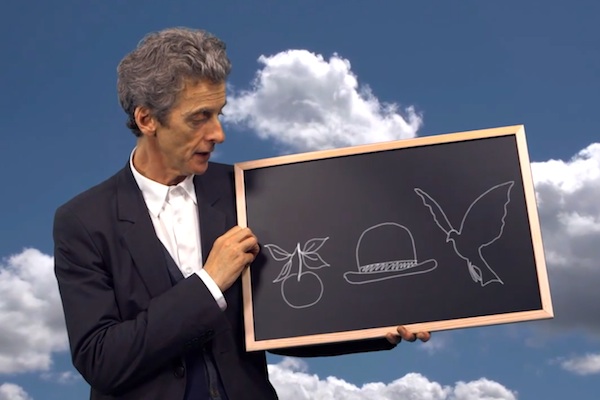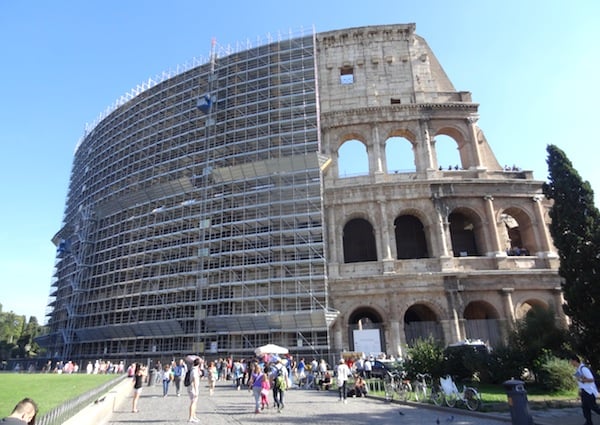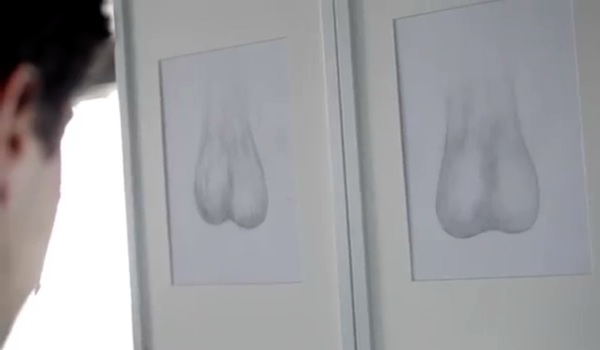Art & Exhibitions
The Essentials: Scrubbing the Colosseum, Dr. Who Explains Surrealism, and More Art News to Start Your Week
Plus a visit to Andrew Wyeth's favorite diner and what are the arts worth, exactly?

Plus a visit to Andrew Wyeth's favorite diner and what are the arts worth, exactly?

Benjamin Sutton


Rome’s Colosseum under renovation.
Photo: Benjamin Sutton.
The Behind-the-Scenes Feature: Rome’s Colosseum is in the midst of a mutli-year, top-to-bottom clean-up—its first comprehensive restoration ever—which will cost a total of €35 million and last through the end of 2016. It involves surrounding the hulking Roman structure in scaffolding, undoing shoddy renovation jobs of the past, blasting its walls with water jets, blotting them with ammonium bicarbonate compresses, and scrubbing at its surfaces with trusty toothbrushes, the Wall Street Journal reports. “When you have the chance to put up scaffolding on an ancient monument and look closely while you’re cleaning, you discover things you would never otherwise see such as frescoes, stucco work, inscriptions and graffiti,” says Roman archaeology professor Clementina Panella of La Sapienza University in Rome.
The Study: In response, one imagines, to rhetoric surrounding recent cuts to culture budgets in the UK attempting to quantify the value of the arts in economic terms, the London School of Economics has done just that, publishing results of a study that sought to ascribe annual payments to various activities from participating in cultural activities to visiting the library. The report, released by the Department for Culture, Media and Sport and to be used by British Prime Minister David Cameron in future decisions regarding culture spending, surveyed responses from 40,000 households and found that dancing is the most valuable cultural activity, bringing people a level of happiness equivalent to a raise of £1,671 ($2,804) annually, the Telegraph reports. Swimming was found to be the second-most valuable activity, and though participating in the visual arts did not register in the survey, “taking part in craft activities” was deemed to be equivalent to a £1,000 ($1,679) per month pay raise.
The Profile: Not to oversell it, but I suspect that Kara Walker‘s forthcoming Creative Time commission at the Domino Sugar Factory in Brooklyn—titled, officially, “A Subtlety, or the Marvelous Sugar Baby an Homage to the unpaid and overworked Artisans who have refined our Sweet tastes from the cane fields to the Kitchens of the New World on the Occasion of the demolition of the Domino Sugar Refining Plant”—will be the most important public art project of 2014, and this interview with the artist in the New York Times by Blake Gopnik (who recently began a series of video-reviews with Christian Viveros-Fauné for artnet News) provides a nice sneak peek at the project and gives a good psychological profile of one of our most important living artists.
The Interview: What was it like to wait on Andrew Wyeth at his favorite diner? Vicki Sylvester, a longtime employee at Hank’s Place, the restaurant in Chadd’s Ford, Pennsylvania where the late artist often ate with his model Helga Testorf, tells the Washington Post that the artist was never hassled while he sat at the counter eating. “They wouldn’t bother him in here,” Sylvester recalls. “People would sometimes come in and say they’d seen an old man up in the woods painting. And we’d say, ‘Yes, that’s probably Mr Wyeth.'”

Peter Capaldi in Tate’s Surrealism video.
Via YouTube.
The Video: In this terrific segment for Tate, actor Peter Capaldi—who is currently playing Dr. Who on the same-named show—offers a crash course on Surrealism, with a healthy dose of sarcasm. “A lot of Surrealist art is about sex,” Capaldi explains, “because Freud believed that the primary motivation for all things in life was sex. He changed his mind later.”
The List: TIME magazine’s list of the 100 most influential people may be headlined by Beyoncé, but it also features a number of art world figures, including Qatar Museums Authority chief Sheikha Al-Mayassa bint Hamad bin Khalifa Al-Thani—whose profile was written by Takashi Murakami—performance artist Marina Abramovic—whose buddy and fellow sometimes-artist, sometimes-celebrity James Franco wrote her profile—and Oscar winning artist-turned-filmmaker Steve McQueen, of whom Lupita Nyong’o—one of the stars of 12 Years a Slave—writes: “He’s always in search of the truthful moment that will give the audience real human access to difficult issues. He’s a visionary in that way.”
The Gadget: In its profile of the London-based design firm Bare Conductive, the Guardian focuses primarily on the possible marketing applications of the electricity-conducting paint the group has developed, but it’s not hard to imagine the incredible ends to which visual artists might put the wondrous substance. The high-tech paint, which becomes a conductor when it dries due to its high carbon content, could surely spark some shocking artistic experiments.
The Eye Candy: Photographer Rachel Sussman has visited every continent in the past decade to take pictures of the oldest living things in the world, from a 2,000-year-old baobab in South Africa to 5,000-year-old pine trees in California. That project, compiled in the new book “The Oldest Living Things in the World” from the Chicago University Press, is the subject of a Wall Street Journal slideshow that will give you serious travel envy.
The Extra Eye Candy: Moving from enduring natural organisms to entirely man-made landscapes, artist Mishka Henner has created several series of aerial photographs in which she documents America’s oil and beef industries, and its military installations in images that appear abstract and beautiful, but also threatening and alarming. The Financial Times has compiled a selection of Henner’s creepy-beautiful, drone-evoking images.
The Book: “Van Gogh on Demand: China and the Readymade,” University of California, Berkeley professor Winnie Wong’s new book on the artists of the urban village Dafen—located within the southern Chinese city of Shenzhen—chronicles the lives of painters churning out thousands of high-quality replicas of famous paintings by Western artists every year. “This kind of [replication] is part of a long history of art that goes back to the Renaissance,” Wong tells the Wall Street Journal, which really outdid itself with the headline “In China, Art to Gogh.” “Most of the workers don’t have a formal arts education, but my book argues that we should understand them pretty much as we understand all artists, no matter where they’re based, or what context or market they’re working for.”
The Cause: After New York’s Ashkenazy Acquisition Corporation and the Irish investment group Tribeca Holdings bought East London’s Old Spitalfields Market last year for £110 million, they attempted to evict longtime newsagent Ashok Patel. Thankfully, the Art Newspaper reports, loyal customer and former YBA Tracey Emin—who has a studio and home nearby—launched a petition and met with Tribeca Holdings to save Patel’s business, which stocks many art publications.

A faux documentary that is actually a commercial for soap occasions some hilarious drawings of testicles.
Image via video screengrab.
The Joke: In an Onion-worthy mockumentary short (that turns out to be an ad for one of the world’s biggest soap manufacturers), forensic artist Nancy Smith of the Encino Police Department drew men’s testicles based on the men’s own descriptions and those of others, and the side-by-side comparisons provoke heartfelt and empowering tears from the men who had alternately described their testicles as being “like a bag of old rags,” and “like a frog that died and has been baking in the sun for two or three days.” As one of the men concludes, weeping: “Those balls are angry, and have no friends; and these are alive and have hope.”
The Feud: You’d think the city of Arles in the South of France would be big enough for two internationally-renowned art organizations, and yet the beloved photography festival Les Rencontres d’Arles and the comparatively new Luma Foundation are butting heads over the latter’s plans for a site the former has been using for years, as the Financial Times reports. A disused rail yards whose warehouses have hosted photography exhibitions in recent years will soon sprout a Frank Gehry building funded by the Luma Foundation, which is headed by Maja Hoffmann. “Seven years ago, I suggested to Maja Hoffmann that she buy these ateliers to refurbish them for Les Rencontres d’Arles,” said François Hebel, who resigned as director of Les Rencontres this year. “But in 2009 she changed her mind and came up with the project of a contemporary art centre. She wanted, little by little, to expel Les Rencontres.”
The WTF: On the occasion of Don Thompson’s new book The Supermodel and the Brillo Box: Back Stories and Peculiar Economics from the World of Contemporary Art, the New York Post‘s Maureen Callahan takes stock of the art bringing in the highest prices at auction these days in the most naive, nuance-less, and jingoistic—ie. New York Post-branded—terms imaginable. “The newer and more outré, the more middle-aged billionaires believe they have modern tastes,” Callahan writes. “It’s a cynical attempt to be cool by consumption, and increasingly, the artists they collect create work for them that verges on contemptuous.”
The Extra-Curricular: In a fascinating look at the various web-based companies whose major business innovation has been to cut out the middlemen in long-established businesses—like Uber with taxi companies or Airbnb with hotels—Slate’s Zachary Karabell draws parallels to everything from the music industry’s crusade against Napster to the Indian economy immediately after the fall of the British empire to question the legal tactics being deployed in US courts today to sabotage such unconventional business models.